
Durango
Bill’s
Glaciology
Glaciology
Alaska’s Melting Glaciers
3 examples of retreating glaciers that can be seen via Alaska’s
26 Glacier Cruise
3 examples of retreating glaciers that can be seen via Alaska’s
26 Glacier Cruise
The most visible aspect of Global Warming is the shrinkage of Alaska’s glaciers due to rising atmospheric temperatures. The most obvious way to see that they are melting is to compare “then and now” aerial photographs of these glaciers.
An easy way to see a large number of Alaska’s glaciers (before they are gone) is via the “26 Glacier Cruise”. https://phillipscruises.com/ This cruise can be taken while you are on an ordinary tourist ocean cruise trip to Alaska.
We will take a brief pictorial visit to 3 of the tidewater glaciers that can be seen from this cruise trip – the Harriman, Surprise, and Barry Glaciers that are located in the western fjords of Prince William Sound. All you have to do to see these glaciers is sign up for the 26 Glacier Cruise as part of your Alaskan cruise trip. A bus will pick you up at your ship in Anchorage, transport you to Whittier, and all you have to do is walk down the gangplank to your glacier cruise boat.
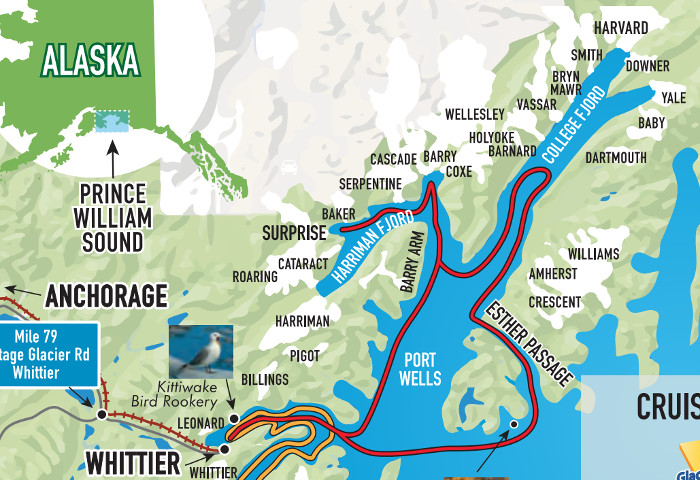
The map above is from the 26 Glacier Cruise Guide. The 3 glaciers that we are going to look at (Harriman, Surprise, and Barry) are north and west of Harriman Fjord.
Harriman Glacier
The Harriman Glacier had been one of Alaska’s few advancing glaciers up until a few years ago; but now, it too is beginning to retreat. Tidewater glaciers get their name because they terminate at sea level in protected fjords. In addition to ordinary atmospheric melting, the underwater base of a tidewater glacier is melted by “warm” ocean water. As the underwater base of a tidewater glacier melts, there is nothing left to support the above water portion. The collapse of the above-water portion produces the spectacular “calving events” that are often shown in Alaskan videos. (For example, see the 2nd video below.)
However, if/when the debris carried by a tidewater glacier produces a terminal moraine in between the glacier’s terminal ice front and the ocean; then calving decreases or stops. The reduction/cessation of oceanic melting will allow some tidewater glaciers to grow simply because melting decreases faster than the decrease in snowfall due to global warming. (Please see http://www.durangobill.com/TakuGlacier/TakuGlacier.html for a more thorough explanation of this process.)
For awhile, the Harriman Glacier grew because of this decrease in calving, but recent satellite photographs show that melting due to Global Warming has overwhelmed even the protection offered by Harriman’s underwater terminal moraine. The result is that now, even the Harriman is beginning to shrink.
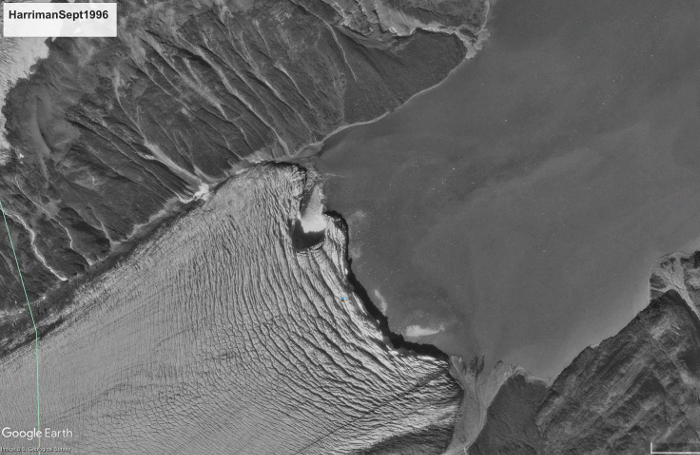
The picture above is a Google Earth, Sept. 1996 view of the Harriman Glacier. For photo comparison purposes, draw an imaginary line from the stream delta near the lower edge of the photo to a small mud flat near the glacier’s terminus on the opposite shore.
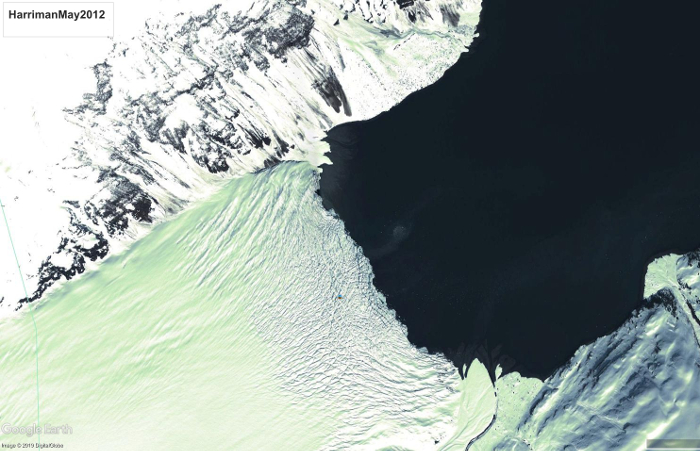
The above picture (also from Google Earth) shows the same view but as of May 2012. It appears that the Harriman Glacier advanced a few hundred feet over the intervening 16 years.
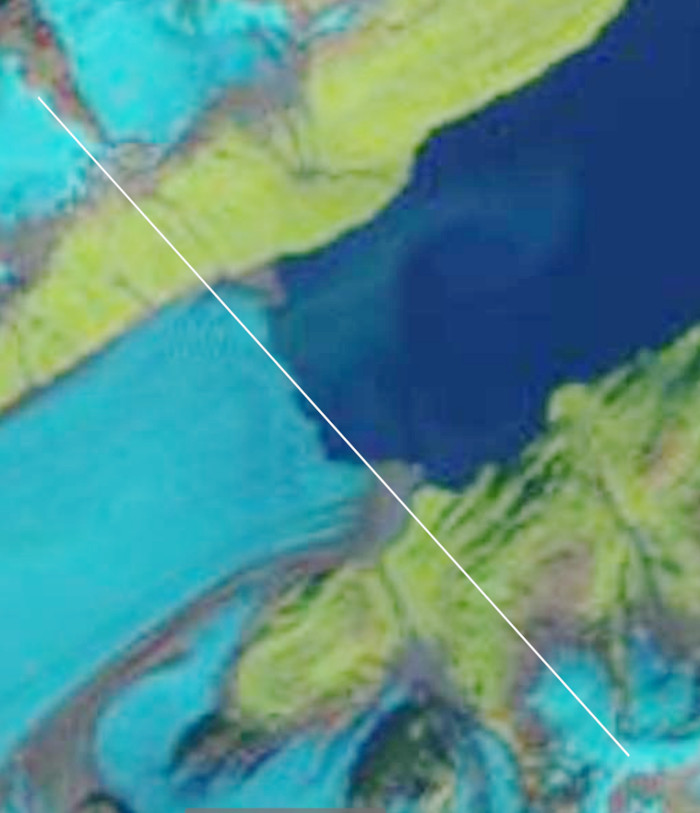
The picture above is a Sept. 30, 2016 Landsat view of the Harriman Glacier. Glaciers are normally at their most retreated annual extent during Sept., so this view shows the Harriman at its most retreated position for the year, but in its most advanced overall position. A line is drawn from a mountaintop at the lower right to the edge of a ridge in the upper left.
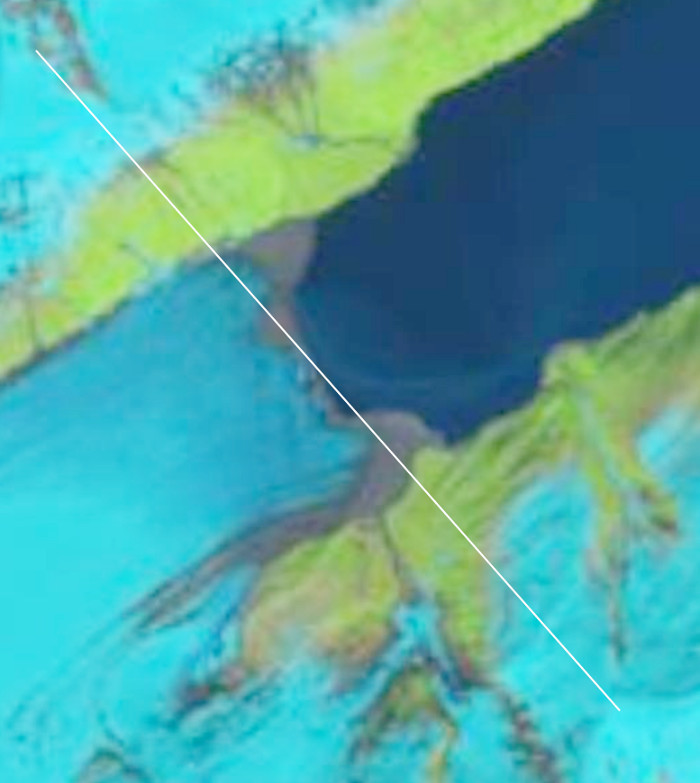
The picture above is a June 21, 2019 Landsat view of the Harriman Glacier. Glaciers are normally at their most advanced annual extent during June., so this view shows the Harriman at its most advanced position for the year. A line is drawn from a mountaintop at the lower right to the edge of a ridge in the upper left.
If you compare the position of the terminus in the 2016 and 2019 views, it can be noted that the Harriman Glacier has started its retreat during the 3-year period - and the whole summer melt season is just starting. Note the mud flat (which is the terminal moraine) that is beginning to appear in front of the glacier.
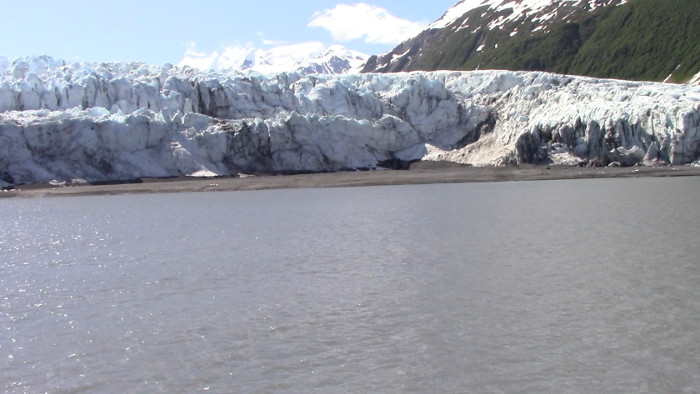
The photograph above was taken by the author on June 10, 2019 and shows the terminus of the Harriman Glacier. The Harriman Glacier is started to melt back from its most advanced position - leaving an exposed muddy/silty sandbar that had been formerly covered with ice. Note that there are no icebergs in the fjord indicating the face is no longer calving into the ocean.
Surprise Glacier
If you take the 26 Glacier Cruise trip, you will get up close to the Surprise Glacier. (Not too close because a sudden calving event of multiple tons of ice might have an “adverse effect” on the boat’s ability to float. See 2nd video below.)
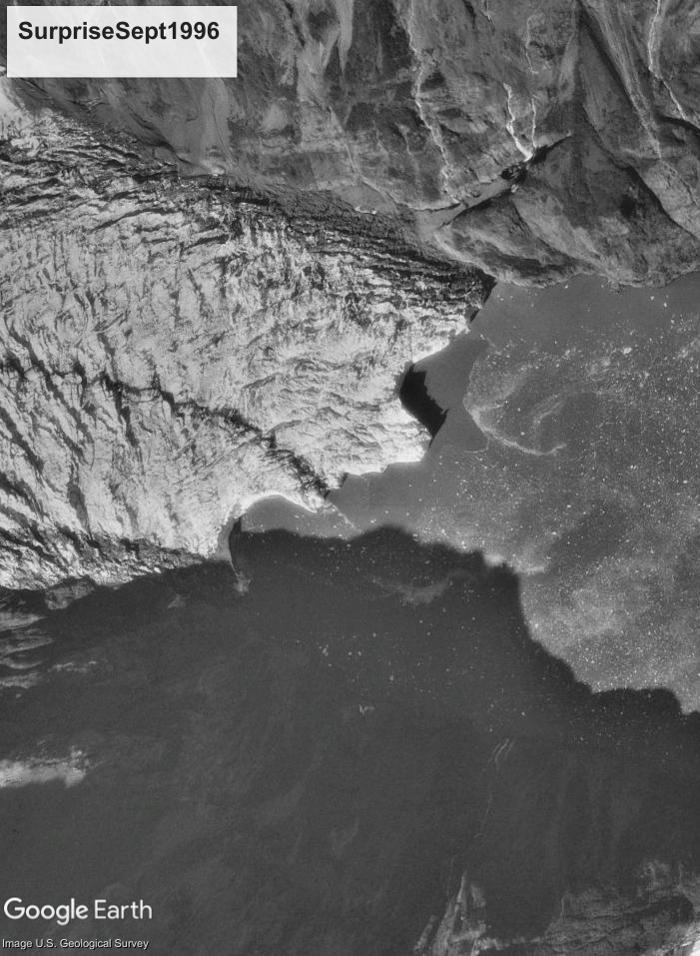
The picture above is a Google Earth view of the Surprise Glacier as of Sept. 1996.
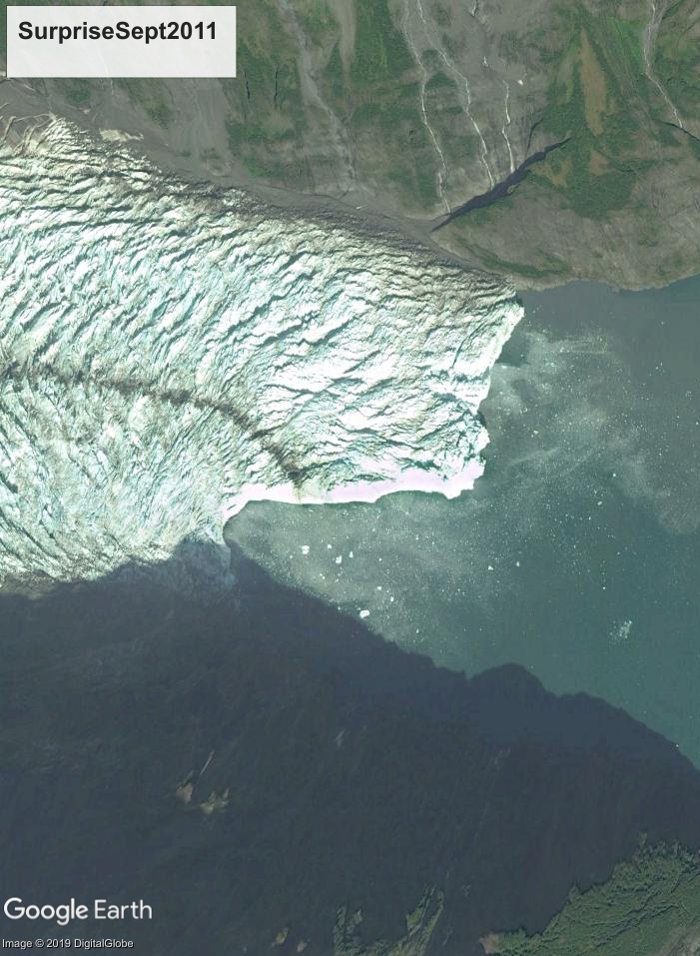
Similar to the Harriman Glacier, the Surprise Glacier advanced slightly from 1996 to 2011.
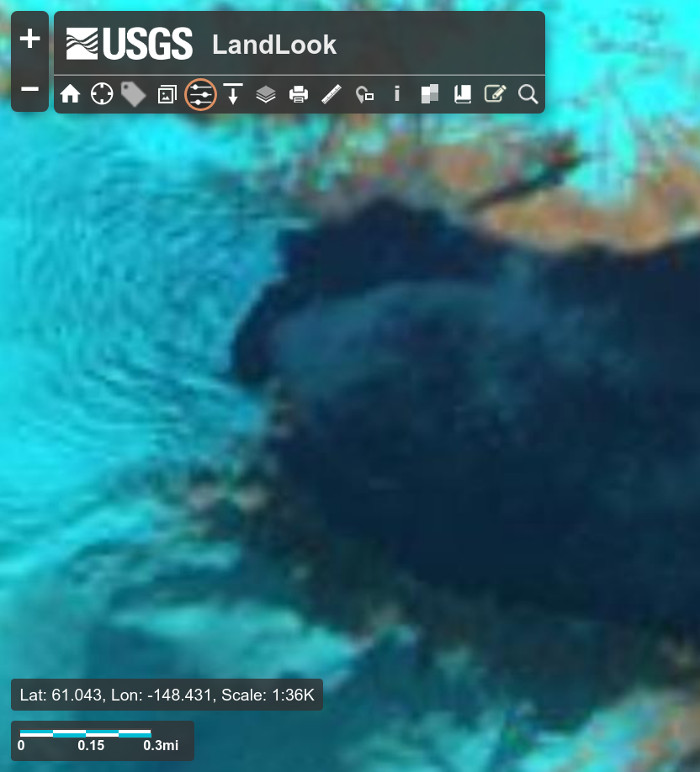
The picture above is a false color satellite view of the Surprise Glacier in April 2019. The retreat of the glacier’s terminus from 2011 is over ½ mile. For example, compare the glacier vs. the rock fissure just above the 2011 terminus. In the 2019 picture the glacier's terminus is well to the left of the rock fissure. The Surprise Glacier is now retreating rapidly.
Barry Glacier
The Barry Glacier has been in full retreat since 1996.
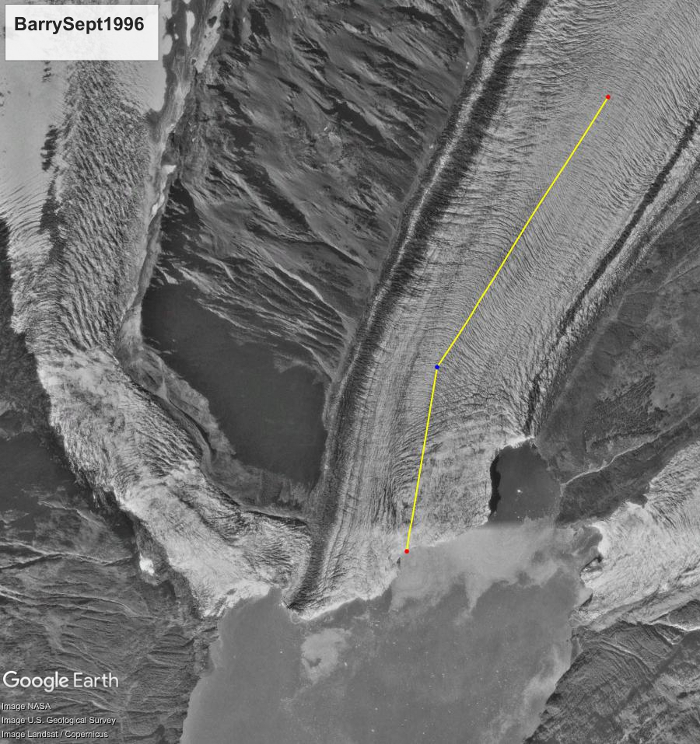
The picture above is a Google Earth view of the Barry Glacier as of Sept. 1996. The Cascade Glacier enters from the top left and just joins the Barry for a combined tidewater front. The Coxe Glacier enters from the lower right edge.
The yellow line superimposed on the Barry Glacier is Google Earth’s measuring tool. It is used to show how much the Barry Glacier has retreated.
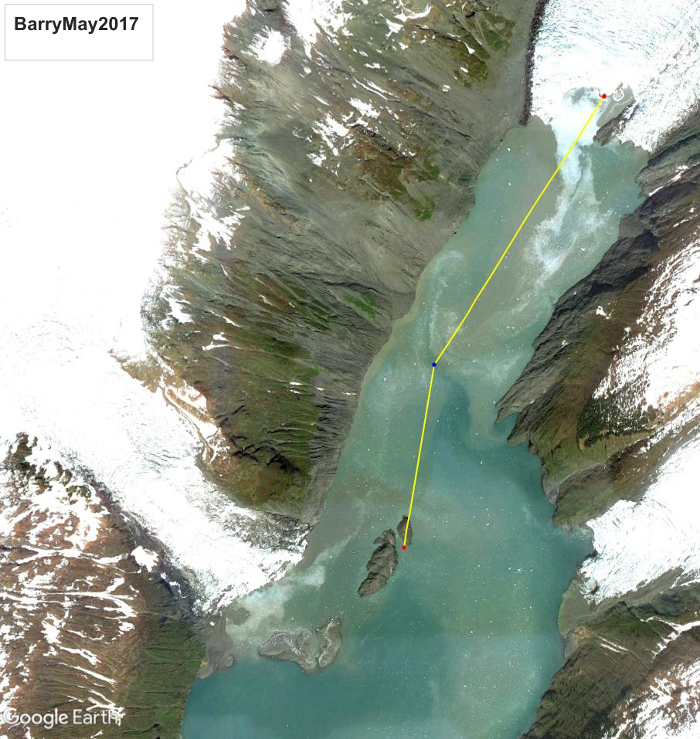
The picture above is another Google Earth view, but as of May 2017. Both the Cascade and Coxe Glaciers have retreated slightly. However, the Barry Glacier has retreated a full 2 miles in just 21 years. If you could have taken the 26 Glacier Cruise in 1996, the Barry Glacier would have put on a spectacular show with frequent calving events into the ocean. If you take the same cruise today, you probably won’t even see the Barry Glacier. (Assumes no change in the tour route.)
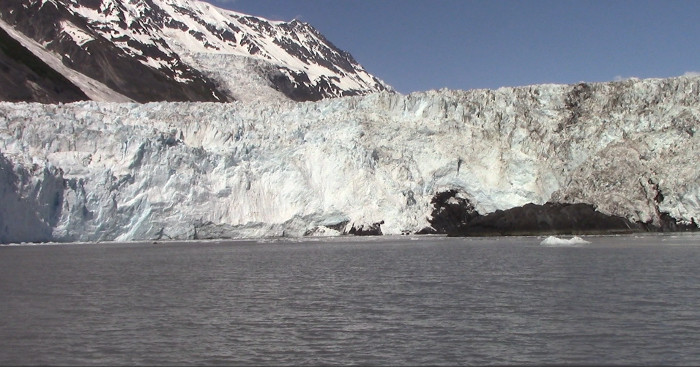
The June 10, 2019 photo above was taken by the author and shows the retreating face of the Barry Glacier. The Barry Glacier has retreated 2 miles in the last 21 years.
Similar fates await anyone who postpones a cruise trip to Alaska. Go see the glaciers as soon as possible. If you procrastinate for too many years, there won’t be any glaciers left to see.
Here are 2 of the author’s videos taken from previous 26 Glacier Cruises that include the above glaciers. (The 2nd video includes a “very very large calving” event of the Surprise Glacier.)
2014: https://www.youtube.com/watch?v=q3dGASPPaek&feature=youtu.be
2017: https://www.youtube.com/watch?v=_nzO_RcrEWw&feature=youtu.be
(Calving at 14:00 into the video)
Also, please see:
The Taku Glacier: http://www.durangobill.com/TakuGlacier/TakuGlacier.html
Return to Durango Bill's Home page
Web page generated via Sea Monkey's Composer HTML editor
within a Linux Cinnamon Mint 18 operating system.
(Goodbye Microsoft)